
BLUEBERRY FIELDS FOREVER….
This week we are delighted to introduce an additional blueberry farm which will help us extend the season, giving us more time to enjoy the wonderfully sweet, round berries.
The KAYMA FARM is a very special enterprise which combines farming, social activitiy and youth. I asked Niv of Kayma to acquaint us with the farm:
The Kayma Farm, located in a valley between Beit Zayit and Ein Karem, was established with the goal of creating a unique work environment for teens who have mustered the courage to seek a different reality. On this farm, we grow crops, primarily seasonal vegetables, using natural methods. We sell these crops to our regular customers and partners from neighboring areas. Within this dynamic, vibrant pursuit, the youth are integrated as full-fledged employees within the multi-age team.
Our new blueberry patch was first planted last year, following several years in which we cultivated a small experimental plot. Within this plot are six different varieties which we selected primarily for the taste and texture of the fruit. Along with the natural growing methods, the cold climate permeating the valley over the winter season enhances the taste of the blueberries. The plants are not sprayed whatsoever, but given solely organic fertilizer – a rare feature in the local market.
Starting this week, Kayma’s excellent-quality blueberries are available for purchase and delivery in your Chubeza box. Once Tamir’s blueberry season ends in another two weeks, Kayma berries will continue to be available for a while longer. ADD THEM TODAY TO YOUR CHUBEZA BOX VIA OUR ORDER SYSTEM!
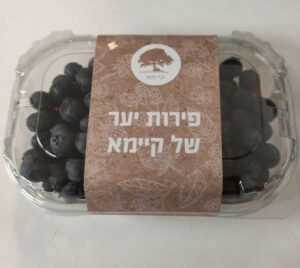
A FIELD DAY IN THE PUMPKIN PATCH
Each year, the summer brings a bevy of new vegetables, among them the rich array of tempting varieties of Chubeza’s squash and pumpkins. This ensemble comes in green, yellow, orange or beige, dotted and striped, smooth and coarse, round, elongated, pear-shaped, pinecone shaped, sharp, flat, small, large, and even extra-large. What a field day for the lovely colorful curcurbitas (Latin for a genus of the gourd family), all so beautiful and tasty!
This year we grew six different squash varieties, from the giant Tripolitanian pumpkin which can neatly transport a shoeless princess, through the middle-sized Napolitano pumpkin, the familiar butternut squash, the oh-so-orange Amoro squash, the distinctive spaghetti squash, all the way to the compact, fits-in-the-palm-of-your-hand green acorn squash. This broad range spans varieties that differ on the outside and within, varying in colors from yellowish green to salmon to dark orange, and in taste – a mild neutral flavor, or nutty or sweet, and in texture: moist and juicy, dry and starchy or long, thin spaghetti-style.
They began to trickle into your boxes over the past few weeks: first the butternut squash, a pair of green acorn squash, and the orange-hued Amoro pumpkin, striped spaghetti squash or a sumptuous slice of Napolitano pumpkin. Afterwards, it’s time to greet the big mama – the immense Tripolitanian pumpkin that’ll remain with us all the way to winter.
Coming up is the season of small pumpkins in abundance, which you will receive nearly each week. If these quantities seem overwhelming, fear not! We remind you that you needn’t use them right away. We’d rather send these pumpkins to you now, because here, crowded by the hundreds, they have no breathing space. But in your homes, on your kitchen counter or in a wicker basket on the living room table, they’ll keep beautifully while enhancing your décor with a flair. If you keep them dry and ventilated, they’re good for another month or even two! If they start growing a thin spider-like web, just wipe it away with a dry cloth to prevent rotting.
The bigger and smaller pumpkins (also known as winter squash) as well as summer squash (including zucchini) belong to the same botanical category and even to the same species. The differentiation between squash and pumpkins is artificial, having to do with the stage at which they are picked and how they are used by human beings. All varieties are seeded (in an open field, in their natural season) from the end of winter/beginning of springtime, and they all grow from spring to the end of the summer.
We pick the “summer squash” early, before they fully ripen, when their shell is thin and their seeds are undeveloped, sometimes as early as 40 days after seeding. Since we pick the fruits off the plant before it had time to produce fertilized seeds, the plant makes additional attempts, yielding more and more seed-bearing fruit in order to fulfill the aim of all plant-life (and animal-life): to spread its genes. Thus, we gain a long harvest season from a plant that just keeps on yielding. These squash varieties do not keep for long, which is why in the past they were only eaten during their natural season, in spring, in summer and early fall. Today, squash is also grown in wintertime in hothouses, so it’s not really seasonal.
Pumpkins (large and small), however, are picked as they ripen and mature, when their shell is thick and hard and their seeds are quite large and hard (and crackable). Since we wait till the ripening is complete, they are harvested some three to five months from seeding day. Our giant Tripolitanian pumpkin often forces us to wait patiently for half a year. Its hard shell allows it to keep nicely for several months, enabling this yummy pumpkin to be eaten in wintertime as well. This offers a particularly significant advantage in the pumpkin’s ancestral home of North America in those areas where it is too cold to grow food during winter. Pumpkins were easily stored in silos, offering sweetness and a summery zest to the cold wintery days. Hence the name for the small varieties – winter squash.
Here are some family members that you have already met this season:

The acorn squash originates in Mexico and the U.S. where Native Americans cultivated the early species. The dark green type which we grow was introduced in 1913 and enthusiastically received, thanks to its excellent taste as well as its small size and thin shell, a source of relief for those battling the huge, hard pumpkins. In the U.S., and especially for those dining alone, it makes a great serving-for-one as well as an ideal stuffed vegetable.
The acorn squash really does taste delicious. Its skin is dry, and its sweet, nutty taste gave it the brilliant name “acorn squash.” Its sweetness enables the acorn squash to go very well with the piquant – olive oil, salt, pepper and herbs – as well as sweet flavors, with a gentle brush of honey or date honey. The ridges lining the fruit make it somewhat difficult to peel, but the good news is that you really do not have to! It’s great to eat right in its shell. And if you still need to eat this squash shell-less, remove the shell only after baking or cooking when it’s a cinch to slip off.
The acorn squash contains more vitamin C and calcium than other squash varieties, and less vitamin A. If you treat it kindly, it will keep for a few months, decorating your tabletop, but its flavor will ebb. So let it adorn your countertops for a week or two, and then whisk it straight to the oven and onto your plates!
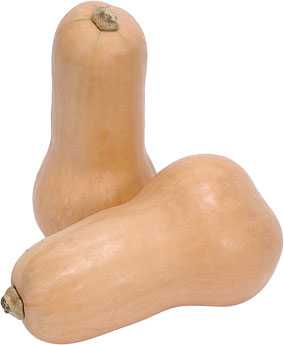
The butternut squash was most likely developed in the 1940s by an amateur gardener (not a farmer or scientist) named Charles A. Leggett while experimenting in species cultivation in a small quarter-acre garden near his house in Stow, Massachusetts. Eventually, Leggett took the fruit of his experiment to the nearby Waltham Field Station to show them what he’d developed. They loved it! He named his baby “butternut” because he thought it was smooth as butter and yummy as a nut. It arrived in Israel in the 1980s, where it received the cutesy name “dalorit.“
The butternut squash is usually fond of hot, humid tropical weather. More than her sisters, the butternut really can’t take cold weather, which is why it is the most popular of Israeli squash varieties. The first species of this type were chubby-looking (with seed-filled bellies) and had long, sometimes curved necks. Over the years, other variations were developed, some with chubby and shorter necks to provide a uniform vegetable demanded by the market. Like zucchini, butternuts can also be picked at an earlier stage, and they’re very tasty when young (some say even more than regular squash). They’re fun to grow in a home garden, where you can pick some to be used as summer squash and allow others to ripen till they become the genuine butternut.
The butternut’s smooth rind makes it easy to peel with just a regular vegetable peeler. It is sweet and its pulp becomes soft after cooking, although there are those who claim that baking makes it better. The butternut is very rich in vitamin A, and under good conditions can be kept for six months (but how could you resist?).

This next girlfriend, Amoro, (whose name must have been coined by a love-struck fella or gal) is an orange, round and flat squash boasting a proud little rump. She belongs to a prominent group we already know: the Kabocha, or Japanese pumpkins (which some call Hokkaido). Their defining characteristics: all are thick and lumpy on the outside, very hard to peel, and have relatively dry flesh.
“Kabocha” is Japanese for squash. The origin of the name comes from the squash’s journey from Mesoamérica to Japan. After the Spanish and Portuguese reached America and discovered the new fruits and vegetables of the land, they began distributing them at upcoming stops on their sailing itinerary. The squash probably arrived in Japan in the mid-16th century via Portuguese sailors who brought it from Cambodia. It was named Cambodia abóbora, which was eventually shortened to become kabocha. And thus, every squash in Japan is a kabocha, which is also the name of this particular group of squash.
The kabocha’s orange flesh testifies to its wealth of beta carotene (vitamin A), which supplies a generous quantity of iron, vitamin C and potassium. It is similar in taste to the acorn squash, but hard to carve, which is why it should be softened first by steaming or light baking (first punch holes in the rind to allow the steam to escape). Then it can be easily cut and seeded for you to proceed and prepare it to your liking.
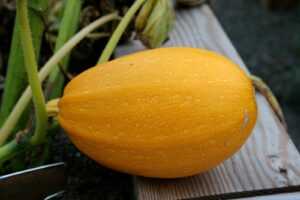
Spaghetti squash, vegetable spaghetti, spaghetti fruit, oranghetti – all are
names for one of the most distinctive squash in Chubeza’s field. After cooking, you can ferret out its flesh with a fork, and then comes the magic: the cooked flash separates into thin strings, a type of thin spaghetti noodles. The spaghetti squash’s flavor is a cross between a pumpkin and a squash, not as sweet as a pumpkin or butternut, but sweeter than zucchini. This is why the “spaghetti noodles” can be eaten just like you would eat pasta: with a fine tomato sauce, olive oil and herbs, pesto, etc. Chubeza’s preferred spaghetti squash variety is the “oranghetti,” developed by the Israeli seed company “Origin.” This orange-hued delight is fortified with beta carotene and boasts a mild sweetness.
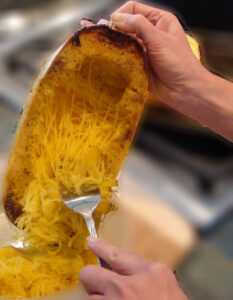
All spaghetti squash recipes start with the same instructions: First cook, steam or bake till the flesh softens (to the point a fork penetrates easily). When the squash is soft, let it cool a bit. If prepared whole, slice lengthwise and remove seeds. With a fork, gently separate the pulp into thin noodles and place them in a bowl. Generally, the spaghetti squash produces a generous quantity of “spaghetti,” and much more than you’d expect to emerge from this amazing vegetable. Thus, apparently, sometimes the parts really are greater than the whole…
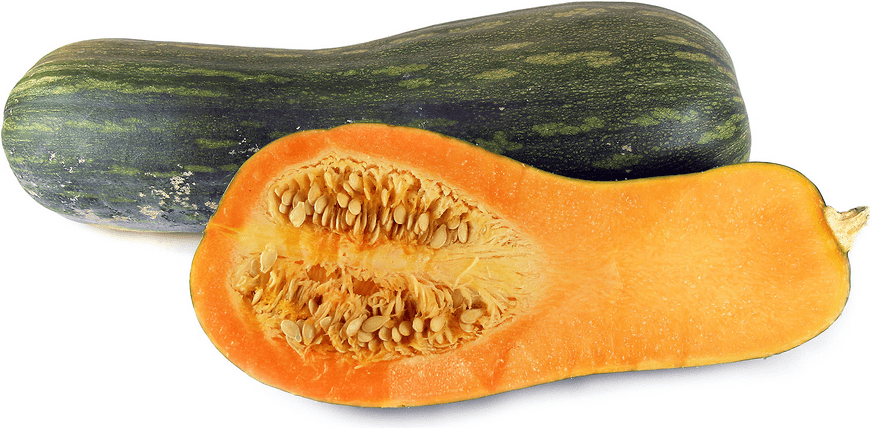
What’s green on the outside, orange on the inside, cylinder-shaped and very long with pumpkin seeds? Meet the Napolitano squash! Chubeza has been lovingly growing it for some years now. It’s sweet and tasty and can be sliced along the width into thick slices, a little like a loaf of bread…
This is a good old vintage squash which has not ceased to please, despite the many years it’s been around. Napolitano even appeared in the illustrated Vegetable Garden by Vilmorin dating back to 1856, which describes the popular vegetables of the era. Despite the passage of years, the Napolitano has not lost its vitality, and is widely grown in Europe and Israel. It’s Italian in origin, as you may have already guessed (and as such can also be used as a threatening gangster weapon, should the need arise).
The Napolitano’s shape resembles a huge butternut squash – with a wide bottom and narrow “bottleneck,” but sometimes it can reach one meter in length! Napolitano weighs between 7-15 kg, sporting a texture similar to the butternut: smooth and more condensed than a regular pumpkin, with a gentle sweetness. Its inside also resembles the butternut, filled with fiber and seeds. If your slice originated in the seed section, use the bonus seeds well, but if you received a piece of “neck,” this is seed-free. Both are super nice!
Napolitano is well-loved in south Italy where it is cooked together with hot peppers, eggplant, tomato, pears and plums in a seasonal soup called Giambotta, or fried and served with various dressings. The seeds are great for noshing, roasted and salted.
The vibrant kaleidoscope of colors and shapes for pumpkins are just one example of what Nature knows how to create. Sometimes human artists take it one step further. So, for dessert – here’s a lovely and crazy pumpkin sculpture by the pumpkin-loving Japanese artist Yayoi Kusama:
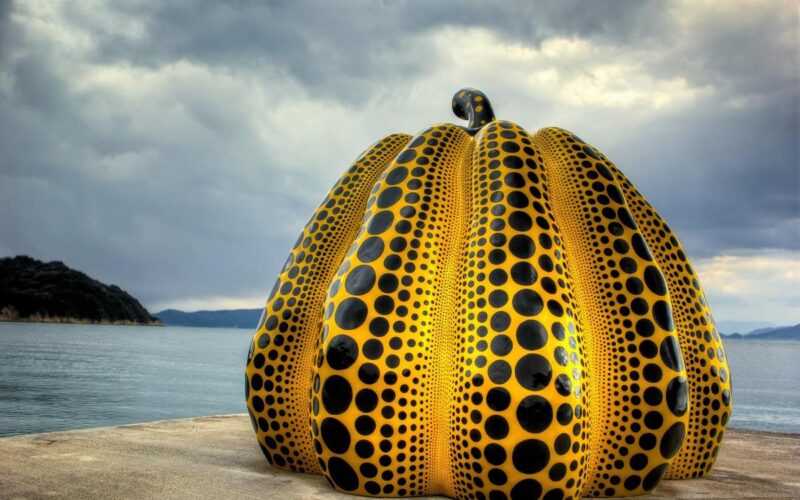
Wishing you the delight of magic, yummy pumpkins and plump, lovable squash!
Alon, Bat-Ami, Dror, Orin, Einat and the entire Chubeza team
________________________________________________
WHAT’S IN THIS WEEK’S BOXES?
Monday: Lettuce, Amoro pumpkin/spaghetti squash/butternut squash/acorn squash, squash/zucchini, eggplant, cherry tomatoes/green or yellow beans/slice of pumpkin, potatoes, parsley, corn, tomatoes, cucumbers, watermelon. SPECIAL GIFT FOR ALL: New Zealand spinach/Swiss chard.
Large box, in addition: Melon/red bell peppers, leeks/onions, basil/coriander.
FRUIT BOXES: Mango, grapes, nectarines. Large box: All of the above + bananas and apples.
Wednesday: Lettuce, Amoro pumpkin/spaghetti squash/butternut squash/acorn squash, squash/zucchini, eggplant, cherry tomatoes/green or yellow beans/okra/green soy (edamame), potatoes, parsley, corn/slice of pumpkin, tomatoes, cucumbers, watermelon. SPECIAL GIFT FOR ALL: New Zealand spinach/Swiss chard.
Large box, in addition: Melon, leeks/onions, basil/coriander.
FRUIT BOXES: Grapes, peach/plum, nectarine/Ana apples. Large box: All of the above + mango/lichi.

